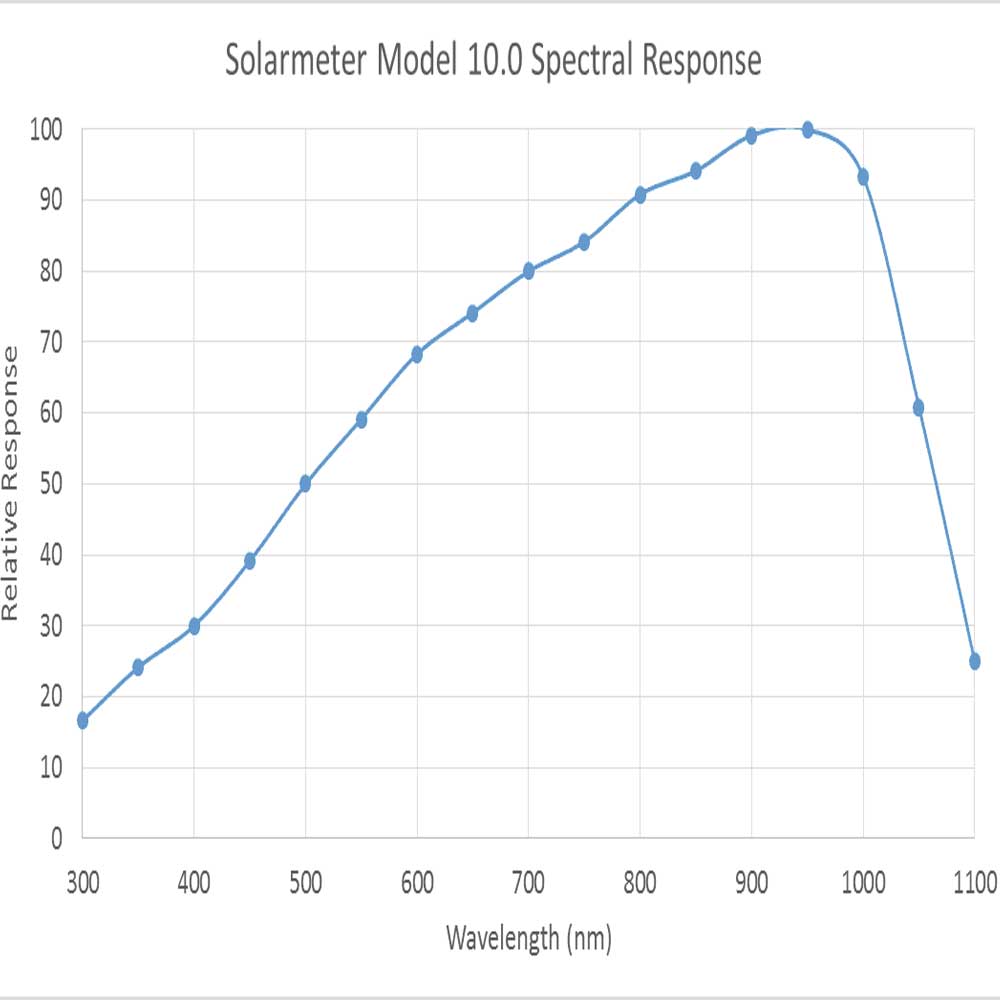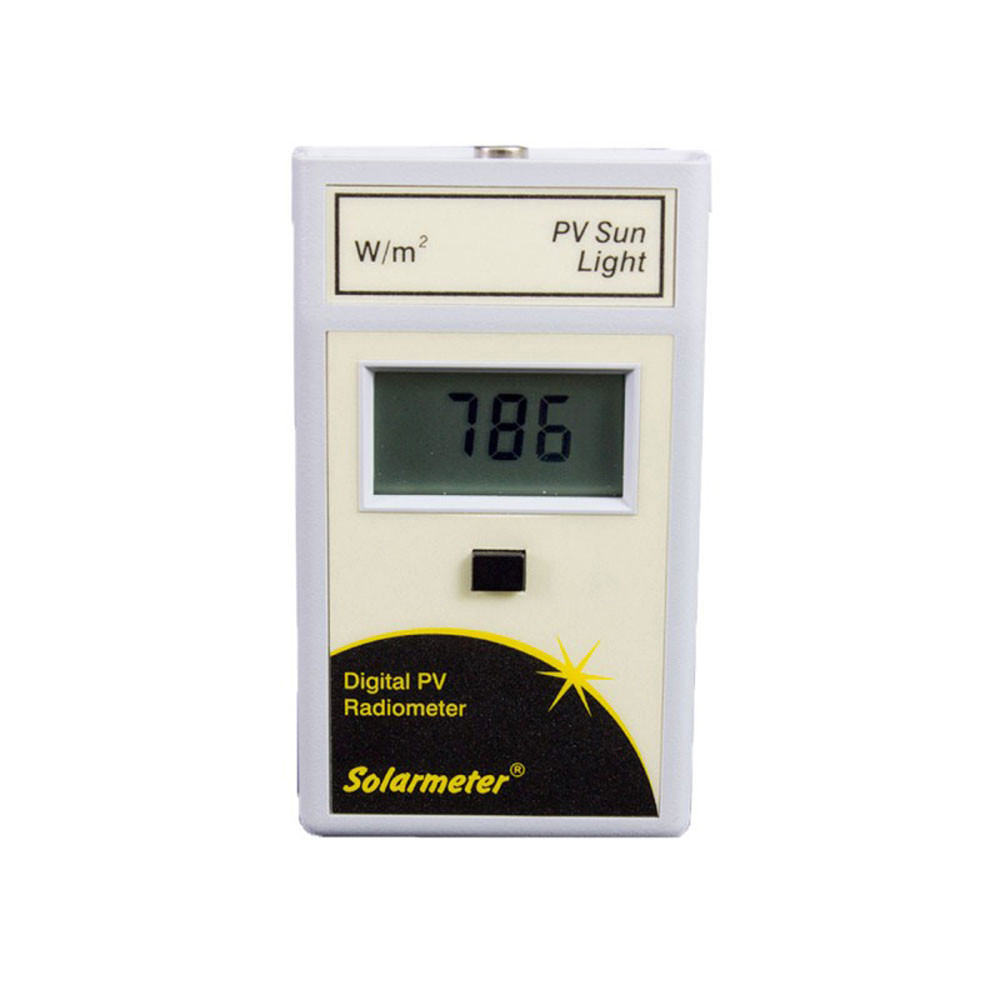• Monitoring of visible light intensity, infrared and ageing
• Measuring the performance of solar panels
• Outdoor solar radiation measurement
• Estimating the photovoltaic capacity
| Model: | 10.0 |
| Irradiation Range: | 0-1999 W/m² |
| Peak Response: | 940 nm |
| Bandwidth: | 400-1100 nm |
| Resolution: | 1 W/m² |
| Conversion rate: | 3.0 Readings/Sec |
| Display: | 3.5 digit LCD |
| Digit Size: | 0.4 (in) / 10.2 (mm) high |
| Operational Temperature: | 32°F to100°F / 0°C to 37.8°C |
| Operational Humidity: | 5% – 80% |
| Accuracy: | ± 5% Ref. WRR |
| Dimensions: | 4.2L x 2.4W x 0.9D (in) / 106.7L x 61W x 22.9(D) (mm) |
| Weight: | 4.5 oz / 128 g (including battery) |
| Power Source: | 9-Volt DC Battery |
| Detector: | Silicon Photodiode |
| Lens: | UV Glas |
| Diffusor: | Teflon |

Sensor/Detector:
AIGaN photodiode with filter.
Operation:
To operate your Solarmeter, aim the sensor window located on the top panel of the meter directly at a source. Press and hold the push-button switch on the face of the meter. For best results take note of the distance the reading was taken from the source in order to ensure repeatable results.
Battery operation voltage is viable from 9V down to 6.5V. Below 6.5V, the numbers on the LCD display will begin to dim, indicating the need for battery replacement. Under typical service load, a standard 9V battery will last approximately 2 years.
Proper Usage of Solarmeter® Ultraviolet Radiometer:
• Wear tinted eyewear or sunglasses when checking intense sunlight.
• Aim sensor directly at sun to see maximum solar irradiance as a reference.
• Aim sensor in same direction as PV panel to see irradiance striking array.
• Re-orient PV panel direction if desired for best average position.
• Maximum solar noon direction will of course vary throughout the year.
Proper Estimation of PV Panel Power:
Before beginning determine the following information from the manufactorer of the module array:
Effective active area for the PV cells in square meters _________________ m²
PV cells efficiency as percentage of input to output power ______________ %
DC to AC conversion efficiency of the PV cell modules in the array _______ %
Also, record the temperature near the back of the array _____________________ °C
It is best to do this when sun is directly shining on module near noon. The meter error will increase (read low) at angles greater than about 35° from direct at-sun conditions.
Example Calculation with PV Meter reading 1000 W/m perpendicular to 10 m array at 10 m active area, 14% cells efficiency, 95% converter efficiency, 40 C:
1000 W/m² x 10 m² = 10000 Watts incoming sun power
• 10000 W x 0.14 cell efficiency = 1400 Watts
• 1400 W x 0.95 conversion efficiency = 1330 Watts
Typical temperature coefficient loss for PV cells is -0.5% per degree C over 25°… or 7.5% for 40° in this example (15° x 0.5% = 7.5% loss or 92.5% of above value. Thus:
• 1330 W x 0.925 = 1230 Watts.
Lastly, a small wiring & component loss of ~1% reduces PV output down to ~1218 W.
Energy Production over Time:
The above 1218 Watts value is an “instantaneous” number. Energy is Watt (or kiloWatt) hours. So if the solar irradiance remained constant for an hour near noon, the energy produced would be 1218 WH. To estimate power over the entire day… take readings every hour and apply the above examples. Then add up each hour’s value x number of hours for daily WattHours. Of course the value will increase toward summer, peaking near June 21 in northern hemisphere… and decrease toward winter, lowest near December 21 solstice. In the southern hemisphere this is opposite.
Maintenance and care:
• Do not expose the meter to extreme temperatures, humidity, shocks or dust. If the meter is accidentally exposed to extreme humidity or damp conditions, unusually high readings may occur. Allowing the meter to dry naturally or placing it in a bag of silicate will restore normal function.
• Use a very soft cloth to clean the meter. Keep the sensor free of oil, dirt, etc.



